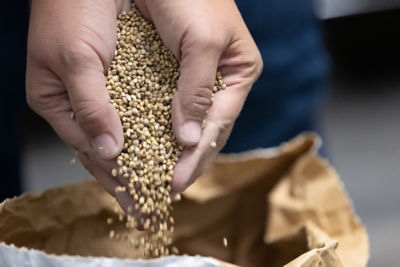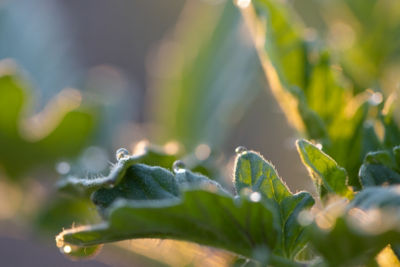Click here to download a PDF version of this spotlight.
» Seed treatments and enhancements can help improve stand establishment, survival, quality, and the appearance of lettuce.
» Seed enhancements include seed priming and seed coating procedures.
» Seed-applied insecticides and fungicides can help protect against yield losses resulting from lettuce pests and diseases.
Lettuce seed can be treated in several ways prior to planting to improve quality and yield potential. The term “seed treatment” typically refers to the application of insecticides and/or fungicides to the seed to help protect the seeds and young seedlings from insect pests and fungal pathogens. The term “seed enhancement” usually refers to other processes, such as seed coatings, pelleting, seed priming, or post-priming procedures that are intended to improve the handling and planting of seed, reduce the time to germination, or increase the uniformity of seedling emergence.
SEED ENHANCEMENTS
Seed enhancements are “post-harvest treatments that improve germination or seedling growth or facilitate the delivery of seeds and other materials required at the time of sowing.”1 Physiological treatments can be used to help enhance germination and stand establishment, often by affecting moisture relationships within the seed.2
The first step in germination is the imbibition of water by the seed. Imbibition of water starts the physiological processes that allow the seed to break dormancy and germinate. One way to speed the process of germination after planting is to prime the seed before planting. Seed priming is defined as “pretreatment of seeds by various methods to improve seed germination rate, percentage germination, and improve the uniformity of seedling emergence by controlling the water available in the seed.”3
Seeds are soaked in water-based solutions to start the germination process, but the seeds are dried before they sprout. Soaking in just water (water priming) is the least effective for promoting uniform germination because the uptake of water is not regulated. Osmopriming (soaking in solutions of glycol, glycerol, or mannitol) and halopriming (soaking in salt solutions such as potassium nitrate, calcium chloride, etc.) can result in more uniform germination because water absorption is regulated by the solution.4
Once planted, primed seeds often emerge more quickly and uniformly than non-primed seeds. However, priming can shorten the shelf-life of the seed, so seed should be planted within six to twelve months of priming.3,4
 Figure 1. Various seed coating technologies used for lettuce seed.
Figure 1. Various seed coating technologies used for lettuce seed.
There are several types of seed coatings (Figure 1). Dry coatings (dust coating) are applied by mixing seed with dry powder products. These are sometimes applied on the farm as “planter-box” treatments. The powder treatments can include protectant pesticides (fungicides and insecticides) and lubricants to help improve the flowability of the seeds through the planting equipment. The dosage is limited by seed size and the amount of product that sticks to the seed. The powders may not adhere well, resulting in dust problems and a lack of uniformity.2,5
Slurry coatings involve mixing the product with liquid (usually water) and mixing the seed in the resulting slurry. The slurry method improves the uniformity of application, especially if adhesives, stickers, binders, or glues are included. A powder may be applied after the slurry treatment to absorb any excess liquid.2,5
Film-coating is “the process of applying a colored polymer film material onto the seed surface that completely covers the seed and any pesticide.”6 Film coats are very thin and do not change the shape, size, or weight of the seed, and they can help reduce water loss. Film coats can help improve the flowability of the seed and provide a safe and uniform placement of materials such as pesticides. Treated seed are mostly dust-free and highly visible. The polymer coatings can also slow the absorption of water by the seed, helping to prevent hydration damage in wet soil.2,5,6

Because lettuce seeds are small and elongated, they can be difficult to plant mechanically. Encrustments and pelleting can be used to change the size, weight, and shape of the seed to help improve ease of planting. Encrustment coatings are thicker than slurry coats and film coats, making the seed more uniform in shape, more spherical, and slightly heavier (8 to 500% weight increase). Encrusted seeds are completely covered, but they mostly retain the original seed shape. Encrusted seeds are easier to plant than non-coated seeds when using a vacuum seeder. The thickness of the coating can affect (slow) the seed germination rate.5
Pelleted seeds have the thickest coatings, are more uniform in size and shape, and are heavier. Binders and fillers are used to coat the seed to the point where the original seed shape is no longer apparent. The weight of individual seeds can be increased from 500 to 5000%. Pelleted seeds are easier to handle and plant in operations using belt- or vacuum-seeders with greater precision. More precise planting can help reduce the need for thinning stands after emergence. Pelleted seeds are also somewhat protected from adverse environmental conditions.2,5,7 Pelleting materials can be selected for water absorption and water holding capacity, porosity, and pellet integrity depending on the anticipated planting conditions. It is useful to have pellets that are stable but dissolve quickly when they become moist. Active ingredients, such as pesticides and biological products, can be added to the pelleting material.4,5,7,8
SEED TREATMENTS
Seed-applied biological and chemical products can help protect lettuce seed and seedlings from insect and disease problems and help enhance stand establishment, crop growth, and potential production (Table 1).5 Seedling pathogens of lettuce include various species of Pythium (an Oomycete organism) and the fungus Rhizoctonia solani. It is critical to use the appropriate fungicides for the pathogens present, as a fungicide that is effective against Pythium may not be effective against R. solani, and vice versa. Insecticides applied as seed treatments can help manage lettuce pests such as aphids, leaf miners, flea beetles, and white flies. The availability of seed treatment products for lettuce can vary by country and by state within in the U.S. Check local management recommendations and product labels to determine the products that are registered for use in your area. Always follow the application instructions and use restrictions on the product label.
SOURCES
1Pedrini, S. and Bhalsing, K. 2018. How to pellet seeds. International Network for Seed-Based Restoration. https://ser-insr.org/news/2018/7/25/how-to-pellet-seeds.
2Taylor, A. G. and Harman, G. E. 1990. Concepts and technologies of selected seed treatments. Annual Review of Phytopathology, 28:321-339.
3National agricultural thesaurus and glossary. http://agclass.nal.usda.gov.
4Ernest, E. G. 2023. Primed seed and pelleted seed in vegetable production. Weekly Crop Update, University of Delaware. June 9, 2023. https://sites.udel.edu/weeklycropupdate/?p=22566.
5Afzal, I., Javed, T., Amirkhani, M., and Taylor, A. 2020. Modern seed technology: Seed coating delivery systems for enhancing seed and crop performance. Agriculture 10(11): 526. https://doi.org/10.3390/agriculture10110526.
6Watkins, J. 1994. A film-coated broccoli seed product. Abstracts of the ASHS Western Region Annual Meeting. https://doi.org/10.21273/HORTSCI.29.12.1408e.
7Jeephet, P., Hermhuk, S., Atnaseo, C., Rapeebunyanon, D., Pinta, J., Baomeesri, S., Singsopa, A., Thawong, N., and Kangsopa, J. 2023. Effect of lettuce seed pelleting with plant growth-promoting bacteria on seed quality and bacterial viability after storage. International Journal of Agricultural Technology, 19(5):2079–2092.
8Jeephet, P., Atnaseo, C., Hermhuk, S., & Kangsopa, J. 2022. Effect of seed pelleting with different matrices on physical characteristics and seed quality of lettuce (Lactuca sativa). International Journal of Agricultural Technology, 18(5):2009–2020.
9Matheron, M. 2017. Damping-off. In Subbarao, K., Davis, R., Gilbertson, R., and Raid, R., Eds., Compendium of Lettuce Diseases and Pests, Second Edition. American Phytopathological Society.
Websites verified 8/20/2024
ADDITIONAL INFORMATION
For additional agronomic information, please contact your local seed representative. Performance may vary, from location to location and from year to year, as local growing, soil and environmental conditions may vary. Growers should evaluate data from multiple locations and years whenever possible and should consider the impacts of these conditions on their growing environment. The recommendations in this article are based upon information obtained from the cited sources and should be used as a quick reference for information about vegetable production. The content of this article should not be substituted for the professional opinion of a producer, grower, agronomist, pathologist and similar professional dealing with vegetable crops.
BAYER GROUP DOES NOT WARRANT THE ACCURACY OF ANY INFORMATION OR TECHNICAL ADVICE PROVIDED HEREIN AND DISCLAIMS ALL LIABILITY FOR ANY CLAIM INVOLVING SUCH INFORMATION OR ADVICE.
5916_446750 Published 09/03/2024




